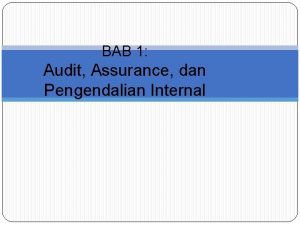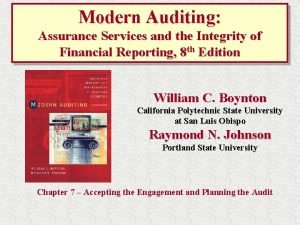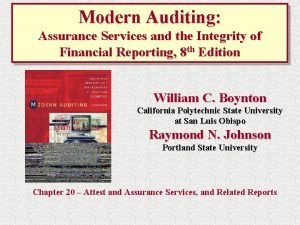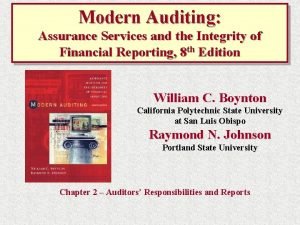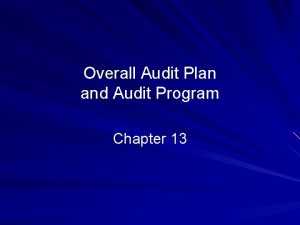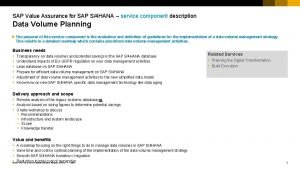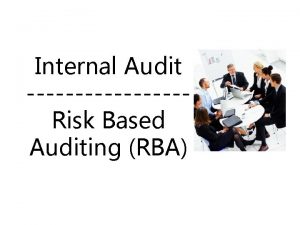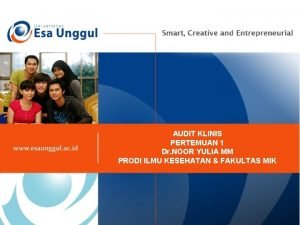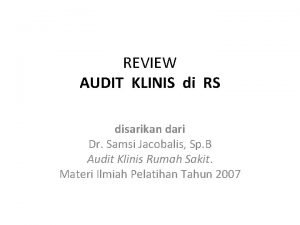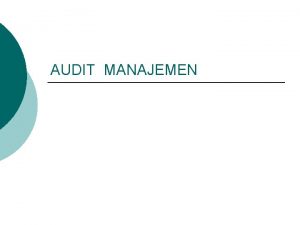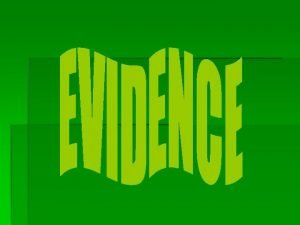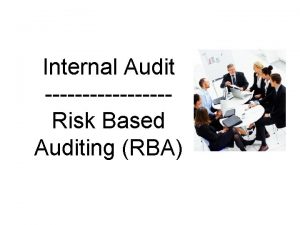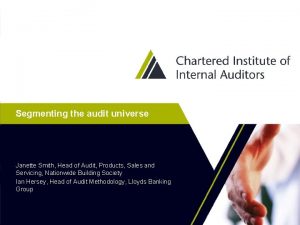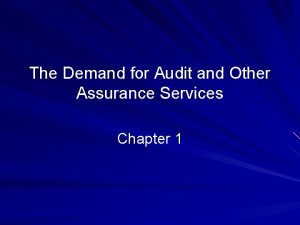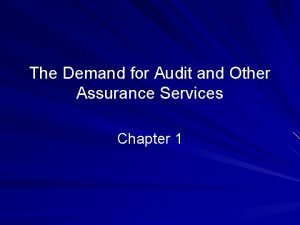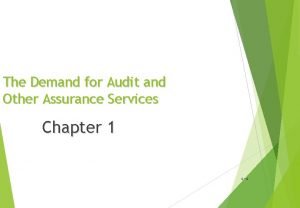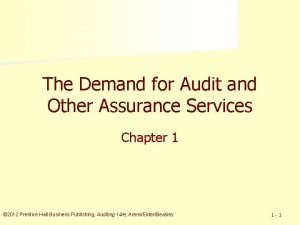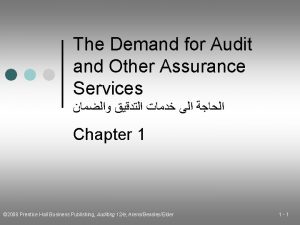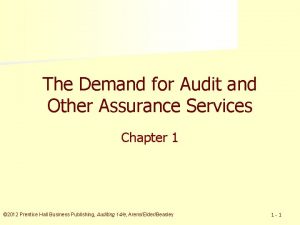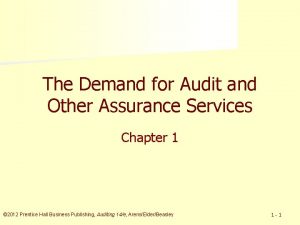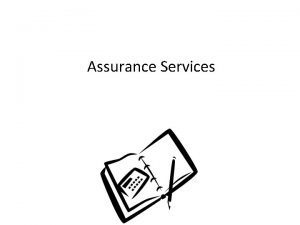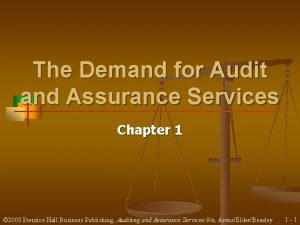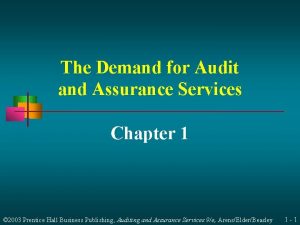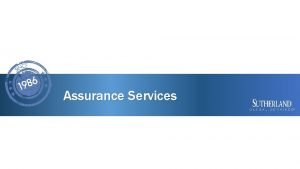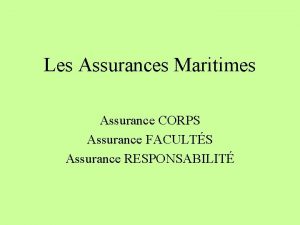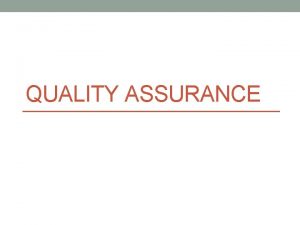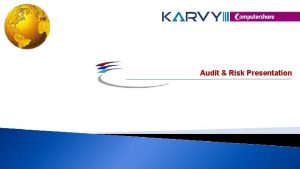The Demand for Audit and Other Assurance Services









































- Slides: 41

The Demand for Audit and Other Assurance Services Chapter 1 © 2012 Prentice Hall Business Publishing, Auditing 14/e, Arens/Elder/Beasley 1 -1

Sarbanes-Oxley Act Enron World. Com The Act established the Public Company Accounting Oversight Board. It also requires auditors to report on the effectiveness of internal control over financial reporting. Tyco © 2012 Prentice Hall Business Publishing, Auditing 14/e, Arens/Elder/Beasley Adelphia 1 -2

Learning Objective 1 Describe auditing. © 2012 Prentice Hall Business Publishing, Auditing 14/e, Arens/Elder/Beasley 1 -3

Nature of Auditing is the accumulation and evaluation of evidence about information to determine and report on the degree of correspondence between the information and established criteria. Auditing should be done by a competent, independent person. © 2012 Prentice Hall Business Publishing, Auditing 14/e, Arens/Elder/Beasley 1 -4

Information and Established Criteria To do an audit, there must be information in a verifiable form and some standards (criteria) by which the auditor can evaluate the information. FASB Criteria © 2012 Prentice Hall Business Publishing, Auditing 14/e, Arens/Elder/Beasley IASB 1 -5

Accumulating Evidence and Evaluating Evidence is any information used by the auditor to determine whether the information being audited is stated in accordance with the established criteria. Transaction data Client inquiry Written and electronic Communications with outsiders © 2012 Prentice Hall Business Publishing, Auditing 14/e, Arens/Elder/Beasley Observations 1 -6

Competent, Independent Person Judgment and Experience Competence Independence Evaluation of Evidence Proper Conclusion © 2012 Prentice Hall Business Publishing, Auditing 14/e, Arens/Elder/Beasley 1 -7

Audit Report To the Board of Directors and Stockholders of ABC Corporation and Subsidiaries Anywhere, USA We have audited the accompanying consolidated balance sheets of ABC Corporation and Subsidiaries (the “Company”) as of December 31, 2010 and December 31, 2009, and the related consolidated statements of income, stockholders’ equity, and cash flows for each of the three years in the period ended December 31, 2010. Our audits also included the financial statement schedule listed in the Index at Item 15. These financial statements and financial statement schedule are the responsibility of the Company’s management. Our responsibility is to express an opinion on the financial statements and financial statement schedule based on our audits. We conducted our audits in accordance with the standards of the Public Company Accounting Oversight Board (United States). Those standards require that we plan and perform the audit to obtain reasonable assurance about whether the financial statements are free of material misstatement. An audit includes examining, on a test basis, evidence supporting the amounts and disclosures in the financial statements. An audit also includes assessing the accounting principles used and significant estimates made by management, as well as evaluating the overall financial statement presentation. We believe that our audits provide a reasonable basis for our opinion. In our opinion, such consolidated financial statements present fairly, in all material respects, the financial position of ABC Corporation and Subsidiaries as of December 31, 2010 and December 31, 2009, and the results of their operations and their cash flows for each of the three years in the period ended December 31, 2010, in conformity with accounting principles generally accepted in the United States of America. Also, in our opinion, such financial statement schedule, when considered in relation to the basic consolidated financial statements taken as a whole, presents fairly, in all material respects, the information set forth therein. We have also audited, in accordance with the standards of the Public Company Accounting Oversight Board (United States), the Company’s internal control over financial reporting as of December 31, 2010, based on the criteria established in Internal Control—Integrated Framework issued by the Committee of Sponsoring Organizations of the Treadway Commission and our report dated February 28, 2011, expressed an unqualified opinion on the Company’s internal control over financial reporting. INTERNATIONAL CPA FIRM LLP Anywhere, USA February 28, 2011 The final step communicates the findings to users. © 2012 Prentice Hall Business Publishing, Auditing 14/e, Arens/Elder/Beasley 1 -8

Audit of a Tax Return Example © 2012 Prentice Hall Business Publishing, Auditing 14/e, Arens/Elder/Beasley 1 -9

Learning Objective 2 Distinguish between auditing and accounting. © 2012 Prentice Hall Business Publishing, Auditing 14/e, Arens/Elder/Beasley 1 - 10

Distinguish Between Auditing and Accounting is the recording, classifying, and summarizing of economic events for the purpose of providing financial information used in decision making. Auditing is determining whether recorded information properly reflects the economic events that occurred during the accounting period. © 2012 Prentice Hall Business Publishing, Auditing 14/e, Arens/Elder/Beasley 1 - 11

Learning Objective 3 Explain the importance of auditing in reducing information risk. © 2012 Prentice Hall Business Publishing, Auditing 14/e, Arens/Elder/Beasley 1 - 12

Economic Demand for Auditing Demand Driver Information risk Auditing can have a significant effect on information risk. What is meant by “Information risk”? © 2012 Prentice Hall Business Publishing, Auditing 14/e, Arens/Elder/Beasley 1 - 13

Learning Objective 4 List the causes of information risk, and explain how this risk may be reduced. © 2012 Prentice Hall Business Publishing, Auditing 14/e, Arens/Elder/Beasley 1 - 14

Causes of Information Risk Ø Remoteness of information Ø Biases and motives of the provider Ø Voluminous data Ø Complex exchange transactions © 2012 Prentice Hall Business Publishing, Auditing 14/e, Arens/Elder/Beasley 1 - 15

Reducing Information Risk Ø User verifies information Ø User shares information risk with management Ø Audited financial statements are provided © 2012 Prentice Hall Business Publishing, Auditing 14/e, Arens/Elder/Beasley 1 - 16

Relationships Among Auditors, Client, and External Users Client or audit committee hires auditor Auditor issues report relied upon by users to reduce information risk Provides capital Client External Users Client provides financial statements to users © 2012 Prentice Hall Business Publishing, Auditing 14/e, Arens/Elder/Beasley 1 - 17

Learning Objective 5 Describe assurance services and distinguish audit services from other assurance and non-assurance services provided by CPAs. © 2012 Prentice Hall Business Publishing, Auditing 14/e, Arens/Elder/Beasley 1 - 18

Assurance Services An independent professional service Can be performed by CPAs or by a variety of other professionals © 2012 Prentice Hall Business Publishing, Auditing 14/e, Arens/Elder/Beasley 1 - 19

Attestation Services ØA type of assurance service ØCPA reports on the reliability of an assertion ØThat is the responsibility of another party. © 2012 Prentice Hall Business Publishing, Auditing 14/e, Arens/Elder/Beasley 1 - 20

Attestation Services 1. Audit 3. Review Historical Financial Statements 2. Internal Control over Financial Reporting 5. Other © 2012 Prentice Hall Business Publishing, Auditing 14/e, Arens/Elder/Beasley 4. Information Technology 1 - 21

Attestation Services on Information Technology Web. Trust and Sys. Trust also meet the criteria of attestation service © 2012 Prentice Hall Business Publishing, Auditing 14/e, Arens/Elder/Beasley 1 - 22

Other Assurance Services Most of the other assurance services that CPAs provide do not meet the formal definition of attestation services. The CPA is not required to issue a written report. The assurance does not have to be about the reliability of another party’s assertion about compliance with specified criteria. © 2012 Prentice Hall Business Publishing, Auditing 14/e, Arens/Elder/Beasley 1 - 23

Green Initiatives Bring Assurance Opportunities, Competition Global interest has triggered a surge in reports. 80% of the Global Fortune 250 released environmental, social, and governance data. Presented in standalone reports or integrated into annual financial reports. © 2012 Prentice Hall Business Publishing, Auditing 14/e, Arens/Elder/Beasley 1 - 24

Other Assurance Services Examples Assess risks of accumulation, distribution, and storage of digital information… including assessing security risks and related controls over data and other information stored electronically, including the adequacy of backup and off-site storage. © 2012 Prentice Hall Business Publishing, Auditing 14/e, Arens/Elder/Beasley 1 - 25

Other Assurance Services Examples Ø Compliance with trading policies and procedures Ø Compliance with entertainment royalty agreements Ø ISO 900 certification Ø Environmental audit © 2012 Prentice Hall Business Publishing, Auditing 14/e, Arens/Elder/Beasley 1 - 26

Assurance, Attestation, and Nonassurance Services © 2012 Prentice Hall Business Publishing, Auditing 14/e, Arens/Elder/Beasley

Learning Objective 6 Differentiate three main types of audits. © 2012 Prentice Hall Business Publishing, Auditing 14/e, Arens/Elder/Beasley 1 - 28

Types of Audits Ø Operational Ø Compliance Ø Financial Statement © 2012 Prentice Hall Business Publishing, Auditing 14/e, Arens/Elder/Beasley 1 - 29

Operational Audit Example Evaluate computerized payroll system for efficiency and effectiveness Information Number of records processed, costs of the department, and number of errors Established Criteria Company standards for efficiency and effectiveness in payroll department Available Evidence Error reports, payroll records, and payroll processing costs © 2012 Prentice Hall Business Publishing, Auditing 14/e, Arens/Elder/Beasley 1 - 30

Compliance Audit Example Determine whether bank requirements for loan continuation have been met Information Company records Established Criteria Loan agreement provisions Available Evidence Financial statements and calculations by the auditor © 2012 Prentice Hall Business Publishing, Auditing 14/e, Arens/Elder/Beasley 1 - 31

Audit of Historical Financial Statements Example Annual audit of Boeing’s financial statements Information Boeing's financial statements Established Criteria Generally accepted accounting principles Available Evidence Documents, records, and outside sources of evidence © 2012 Prentice Hall Business Publishing, Auditing 14/e, Arens/Elder/Beasley 1 - 32

XBRL Electronic Data to Improve Financial Reporting Extensible Business Reporting Language Enables sorting and comparing of financial data Public companies required to provide interactive financial statement data © 2012 Prentice Hall Business Publishing, Auditing 14/e, Arens/Elder/Beasley 1 - 33

Learning Objective 7 Identify the primary types of auditors. © 2012 Prentice Hall Business Publishing, Auditing 14/e, Arens/Elder/Beasley 1 - 34

Types of Auditors Ø Independent certified public accounting firms Ø Governmental general accounting office auditors Ø Internal Revenue agents Ø Internal auditors © 2012 Prentice Hall Business Publishing, Auditing 14/e, Arens/Elder/Beasley 1 - 35

Learning Objective 8 Describe the requirements for becoming a CPA. © 2012 Prentice Hall Business Publishing, Auditing 14/e, Arens/Elder/Beasley 1 - 36

Three Requirements for Becoming a CPA Ø Educational requirement Ø Uniform CPA examination requirement Ø Experience requirement © 2012 Prentice Hall Business Publishing, Auditing 14/e, Arens/Elder/Beasley 1 - 37

CPA Examination Sections Auditing and Attestation Financial Accounting And Reporting Business Environment and Concepts Regulation © 2012 Prentice Hall Business Publishing, Auditing 14/e, Arens/Elder/Beasley 1 - 38

CBT-e: The CPA Exam Gets a Makeover New content and skill specification outline revisions. Exam structure changes and weighting of individual exam components. Coverage of international auditing and financial reporting standards. © 2012 Prentice Hall Business Publishing, Auditing 14/e, Arens/Elder/Beasley 1 - 39

Three Requirements for Becoming a CPA © 2012 Prentice Hall Business Publishing, Auditing 14/e, Arens/Elder/Beasley 1 - 40

End of Chapter 1 © 2012 Prentice Hall Business Publishing, Auditing 14/e, Arens/Elder/Beasley 1 - 41
 Attestation vs audit
Attestation vs audit Audit assurance dan pengendalian internal
Audit assurance dan pengendalian internal Internal audit assurance engagement
Internal audit assurance engagement Module 5 supply and demand introduction and demand
Module 5 supply and demand introduction and demand Modern auditing and assurance services
Modern auditing and assurance services Modern auditing & assurance services
Modern auditing & assurance services Modern auditing and assurance services
Modern auditing and assurance services Vouching in auditing
Vouching in auditing Overall audit plan and audit program
Overall audit plan and audit program Measures to correct excess demand and deficient demand
Measures to correct excess demand and deficient demand Dependent and independent demand example
Dependent and independent demand example Demand schedule para sa
Demand schedule para sa Types of demand forecasting in managerial economics
Types of demand forecasting in managerial economics Paradox of value
Paradox of value Dependent and independent demand in inventory management
Dependent and independent demand in inventory management Sap value assurance services
Sap value assurance services Internal auditing assurance & advisory services
Internal auditing assurance & advisory services Digital assurance services
Digital assurance services Lqa meaning translation
Lqa meaning translation Digital assurance services
Digital assurance services Perbedaan audit konvensional dengan audit berbasis risiko
Perbedaan audit konvensional dengan audit berbasis risiko Clinical meeting
Clinical meeting Beda audit medis dan audit klinis
Beda audit medis dan audit klinis Penyelesaian audit dan tanggung jawab pasca audit
Penyelesaian audit dan tanggung jawab pasca audit Konsep dasar audit
Konsep dasar audit Perbedaan prosedur audit top-down dengan bottom-up
Perbedaan prosedur audit top-down dengan bottom-up Perbedaan audit konvensional dengan audit berbasis risiko
Perbedaan audit konvensional dengan audit berbasis risiko Audit latin meaning
Audit latin meaning Janette loveys
Janette loveys Stochastic inventory model example
Stochastic inventory model example Individual demand vs market demand
Individual demand vs market demand Independent vs dependent demand
Independent vs dependent demand Supply and demand board game
Supply and demand board game Providing support services facilities and other amenities
Providing support services facilities and other amenities Types of repair
Types of repair Fspos
Fspos Novell typiska drag
Novell typiska drag Nationell inriktning för artificiell intelligens
Nationell inriktning för artificiell intelligens Vad står k.r.å.k.a.n för
Vad står k.r.å.k.a.n för Shingelfrisyren
Shingelfrisyren En lathund för arbete med kontinuitetshantering
En lathund för arbete med kontinuitetshantering Personalliggare bygg undantag
Personalliggare bygg undantag

